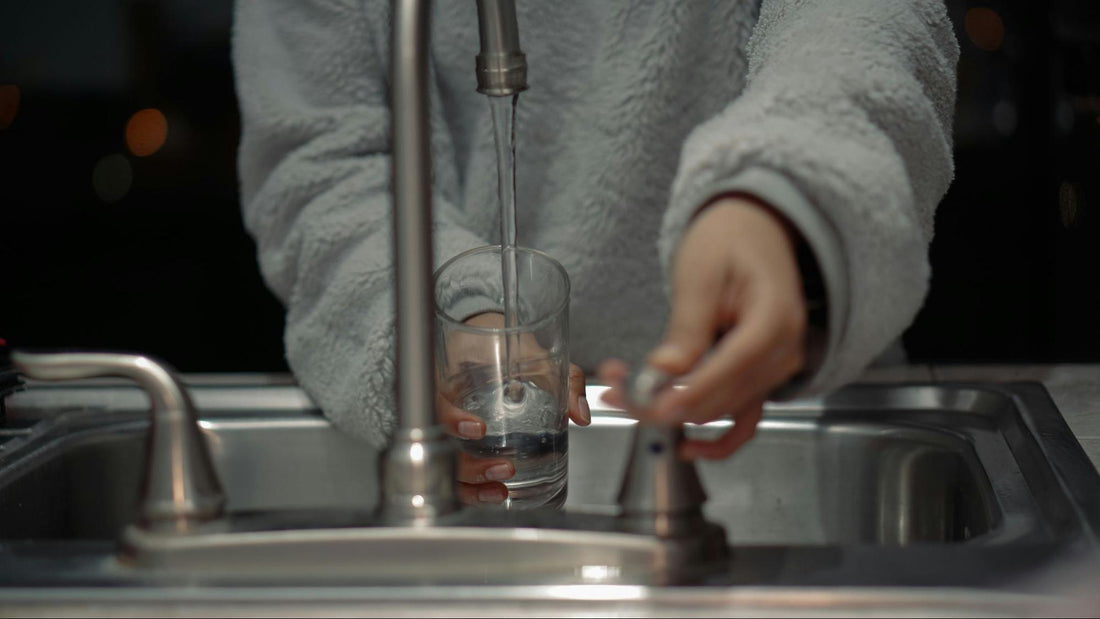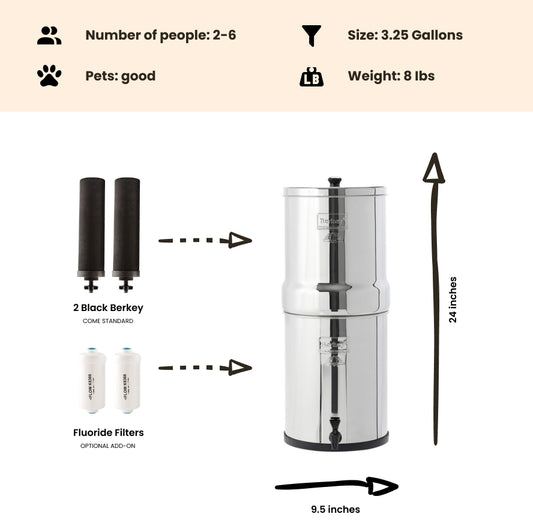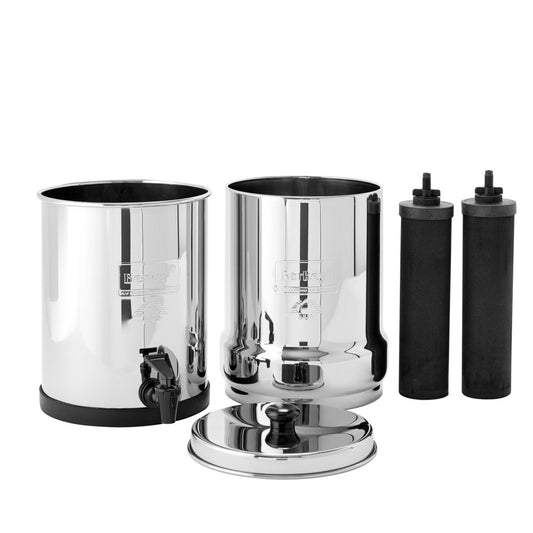
Iron and Manganese in Water: Causes, Effects, and Solutions
By Dan DeBaunShare
It starts with a weird taste. Then come the stains. And finally, the smell.
Suppose you get your drinking water from a private well or are simply concerned about your water quality. In that case, you may have already been faced with strange metallic tastes, orange or black stains on your plumbing fixtures, or even unpleasant odors emanating from your water.
In many cases, iron and manganese are to blame. While these naturally occurring contaminants are not generally considered harmful in small amounts, they are regulated as secondary contaminants as they can cause aesthetic problems in drinking water and serious headaches for homeowners.
This article will explore what iron and manganese in water mean, why they matter, and what practical steps you can take to reduce or remove them.
You will learn:
- What are iron and manganese, and how do they get into your water?
- Why are iron and manganese a problem in domestic water systems?
- Signs your water may contain iron or manganese
- Are iron and manganese harmful to your health?
- How are iron and manganese regulated in drinking water?
- How to test for iron and manganese in drinking water
- How to remove iron and manganese from your water
- Why Berkey systems are an effective defense against iron and manganese
What Are Iron and Manganese, and How Do They Get Into Your Water?
Iron and manganese are naturally occurring metals found in soil and rock. As groundwater moves through these mineral-rich soils, it can dissolve the metals and carry them into private wells and other water sources.
Iron is more common and typically found in higher concentrations than manganese, but they often appear together. Wells are particularly prone to iron and manganese contamination, as these metals can leach into water as it flows through soils and rocks.
Human activities such as mining and industrial runoff can also elevate levels of these metals.
Why Are Iron and Manganese a Problem in Domestic Water Systems?
At first glance, iron and manganese in your water might seem like minor annoyances, maybe a rusty tinge in the toilet bowl or a faint metallic aftertaste in your drinking water. But left unaddressed, these metals can quietly cause more serious problems throughout your home’s plumbing system.
High levels of iron in water can stain sinks, bathtubs, laundry, and even your dishes with persistent reddish-orange marks.
Manganese, on the other hand, tends to leave behind dark brown or black stains that are just as frustrating and difficult to remove.
But the damage doesn’t stop at appearances. These minerals can create an ideal environment for bacteria — specifically iron or manganese bacteria — to thrive. While these microbes won’t make you sick, they produce slimy buildups and foul odors that are anything but pleasant.
Over time, iron and manganese can also accumulate inside your pipes, water heater, and appliances, reducing water pressure and leading to clogging or equipment failures that can be costly to rectify. They may even interfere with water softeners and other treatment systems, making those solutions less effective or requiring more frequent maintenance.
In short, what starts as a subtle nuisance can become a costly, system-wide headache that can lead to costly maintenance and repairs if left untreated.
Signs Your Water May Contain Iron or Manganese
If you are wondering whether iron or manganese might be lurking in your water, there are tell-tale clues that will indicate their presence.
One of the most common and visible signs of iron in well water is staining: reddish-brown, orange, or even yellow marks on your sinks, bathtubs, toilets, and laundry. If you’ve ever pulled a load of freshly washed white clothes from the washer only to find them tinged with rust-colored blotches, iron could be the culprit.
Manganese, though less common, leaves its own signature in the form of dark brown or black stains, particularly around fixtures or in standing water like toilet cisterns. These marks can be stubborn and unsightly, requiring constant cleaning and sometimes permanent replacement of stained surfaces.
But staining isn’t the only giveaway. A metallic taste or odor in your drinking water is another indication that these minerals are present. In more advanced cases, you might notice a black, slimy buildup near faucets, shower-heads, or in your toilet cistern, which could point to manganese bacteria.
And if your water pressure starts to drop for no apparent reason, it could be due to iron or manganese buildup inside your plumbing or filters, restricting flow.
Are Iron and Manganese Harmful to Your Health?
So, is it safe to drink water that contains iron and manganese? The U.S. EPA classifies iron and manganese as secondary contaminants, which means they affect taste, color, and odor but aren’t considered dangerous under normal circumstances.
However, long-term exposure to high levels of manganese has been linked to neurological and behavioral issues, with children being particularly vulnerable. It is therefore safer to err on the side of caution and implement measures to protect your family’s health if you are concerned about manganese in your water.
How Are Iron and Manganese Regulated in Drinking Water?
The EPA recommends the following secondary maximum contaminant levels (SMCLs) for iron and manganese:
- Iron: 0.3 mg/L
- Manganese: 0.05 mg/L
These are not enforceable health-based limits but aesthetic guidelines.
How to Test for Iron and Manganese in Drinking Water
If you are concerned about iron and manganese in your tap water, you can have your water tested to determine whether these contaminants are present, and at what concentrations. There are two primary options for testing for iron and manganese in water:
- Lab Testing: Get your water professionally tested by a certified lab to identify exact concentrations.
- DIY Kits: Home test kits are a good starting point for detecting high iron in water and manganese, though not as precise as lab results.
Testing should be done at least once a year, or immediately if you notice staining or changes in taste or pressure.
How to Remove Iron and Manganese from Your Water
There are several treatment options, depending on the type and concentration of iron and manganese.
Oxidation and Filtration
Oxidation followed by filtration is one of the most reliable and widely used methods for removing dissolved iron and manganese from drinking water.
The process begins by adding an oxidizing agent—such as chlorine, potassium permanganate, or even just air—which reacts with the dissolved metals and transforms them into solid particles. Once oxidized, these particles can be easily captured and removed through a specialized filtration system.
This method is especially effective for treating moderate to high concentrations of iron and manganese and is often used in both residential and municipal water treatment setups.
While it requires proper dosing and periodic maintenance, oxidation and filtration offer a powerful solution for significantly improving water quality.
Ion Exchange Water Softeners
Water softeners are primarily designed to remove hardness minerals like calcium and magnesium, but they can also handle small amounts of iron—typically up to about 2 parts per million (ppm).
However, they are not effective at removing manganese or higher concentrations of iron. Over time, iron can accumulate on the softening resin, reducing its efficiency and potentially leading to fouling, which may require more frequent cleaning or replacement.
If your water contains more than trace levels of iron, it’s best to pair a softener with a dedicated iron removal system.
Greensand Filters
Greensand filters are a popular and reliable option for treating water with iron, manganese, and even the notorious “rotten egg” smell caused by hydrogen sulfide.
These filters use a special media called manganese greensand, which is coated with manganese oxide to help oxidize and trap unwanted minerals. To keep working effectively, the media needs to be regenerated regularly using potassium permanganate, a chemical that restores its oxidizing power.
While a bit more maintenance-intensive and expensive, greensand filters are highly effective for households dealing with multiple nuisance contaminants.
Multistage Treatment
When water contains both dissolved and solid forms of iron and manganese, along with other potential issues like bacteria and hardness, a multistage treatment approach is often the most effective solution.
The process typically begins with chlorination, which not only oxidizes dissolved iron and manganese into solid particles but also disinfects the water by killing bacteria.
Next, mechanical filtration removes the oxidized particles.
After that, activated carbon is used to eliminate any lingering chlorine, improving taste and odor.
Finally, a water softener can help address hardness and filter out any remaining dissolved minerals, leaving you with cleaner, better-quality water.
Alternative Solutions: Switching Water Sources
In extreme cases, the most practical solution may be to drill a new well or switch to a municipal water source, especially if your current supply has persistent issues or contamination.
And if you’re looking for a quick and simple way to deal with iron and manganese in your water, the next section is for you.
Why Berkey Systems Are an Effective Defense Against Iron and Manganese
While Berkey water filters are not designed to treat extremely high concentrations of iron or manganese, they are effective at reducing these contaminants to safe, manageable levels. Berkey systems use proprietary Black Berkey filter elements that remove a wide range of pollutants, including reducing iron and manganese in well water.
Unlike reverse osmosis or chemical-based systems, Berkey filtration is gravity-fed, requires no electricity, and retains essential minerals in your water. It’s a practical, cost-efficient, low-maintenance solution for homeowners who want clean, great-tasting water without the hassle and expense associated with more complex water treatment systems.
Don’t Let Iron and Manganese Ruin Your Water
Iron and manganese might be natural, but they don’t belong in your glass or on your sink. If you’re dealing with a metallic taste, black slime, or stubborn stains, it’s time to take action.
Start by testing your water, then choose the best treatment option based on your results. For many households, Big Berkey water filtration systems offer a powerful, accessible solution that fits right on your countertop and delivers peace of mind with every pour.
Try it for yourself — and taste the difference.
FAQ
Can you drink water with iron and manganese?
Yes, in small amounts. But elevated levels can affect taste and appearance, and manganese may pose health risks with prolonged exposure.
Why are iron and manganese undesirable in water?
They cause staining, bad taste, odors, and damage to plumbing and appliances.
What is the limit of iron and manganese in drinking water?
EPA recommends: Iron: 0.3 mg/L, Manganese: 0.05 mg/L (non-enforceable aesthetic standards).
How to remove iron and manganese from water?
Some options include oxidation/filtration, ion exchange water softeners, greensand filters, or a reliable filter like Berkey.
Does boiling water reduce manganese?
No. Boiling does not remove manganese.
Does chlorine remove iron and manganese?
Yes, chlorine can oxidize these metals, making them easier to filter out with a filter such as the Berkey.
What neutralizes iron in water?
Oxidation followed by filtration is the most effective method.
Is too much iron in water bad for you?
Not usually, but it can cause gastrointestinal issues and promote bacterial growth in pipes.
Does manganese turn water black?
Yes. Manganese often causes black or dark staining and discoloration.
-
Regular price $234.00 USDRegular priceUnit price / per
-
Regular price $327.00 USDRegular priceUnit price / per
-
Regular price From $367.00 USDRegular priceUnit price / per
-
Regular price From $408.00 USDRegular priceUnit price / per
-
Regular price From $451.00 USDRegular priceUnit price / per
-
Regular price From $478.00 USDRegular priceUnit price / per
-
Regular price $332.50 USDRegular priceUnit price / per
$350.00 USDSale price $332.50 USDSale

Dan DeBaun
Dan DeBaun is the owner and operator of Big Berkey Water Filters. Prior to Berkey, Dan was an asset manager for a major telecommunications company. He graduated from Rutgers with an undergraduate degree in industrial engineering, followed by an MBA in finance from Rutgers as well. Dan enjoys biohacking, exercising, meditation, beach life, and spending time with family and friends.
~ The Owner of Big Berkey Water Filters















